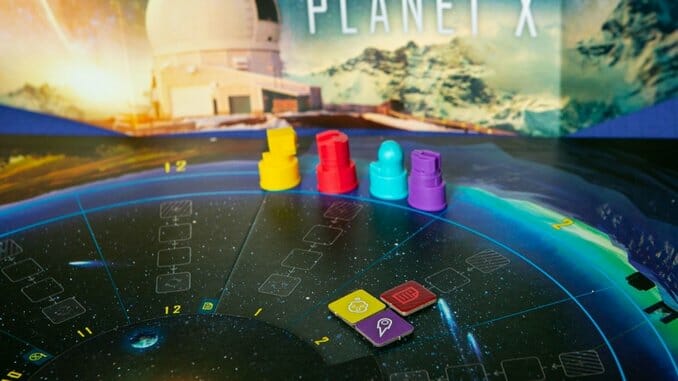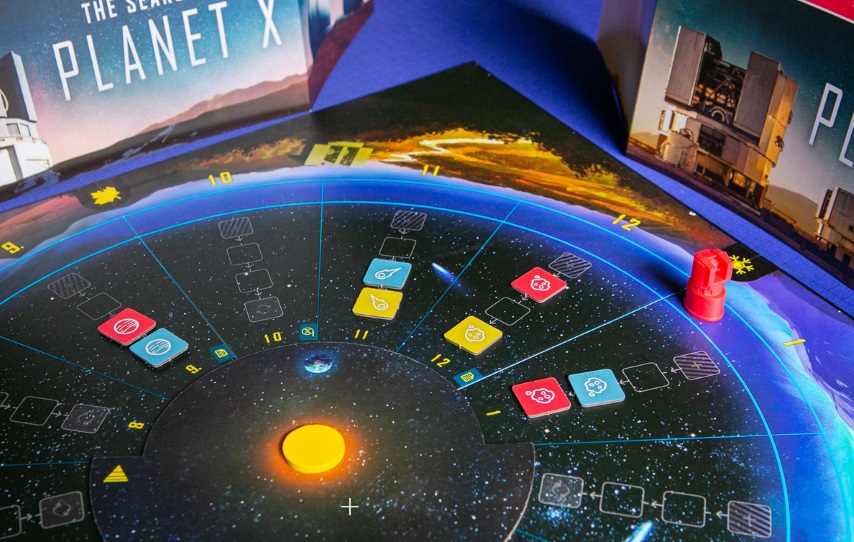We’ve Found One of the Best Board Games of the Year in The Search for Planet X
Images courtesy of Renegade Game Studios
Deduction games make up a small niche in contemporary board gaming, and tend to fall into two categories: social deduction games like Coup, One Night Ultimate Werewolf, or Secret Hitler; or mystery games like Chronicles of Crime, Mysterium, or the Exit games, which are usually cooperative. As a gamer of a certain age, though, I have fond memories of older games that worked like logic puzzles within board games, like the 1985 game Orient Express, or even Clue, flawed as it is, because (grumpy old man voice) back in my day, that’s what board games were, and we liked it.
Enter The Search for Planet X, which fills a very specific gap that also speaks directly to my own interests: It’s a deduction game, with a logic puzzle at its heart, and is competitive (rather than cooperative) with multiple ways to score, so that you can still stay in the game even if you aren’t the first to solve the ultimate mystery. It’s brilliant, one of my favorite games of 2020, and has me feeling nostalgic for the days of GAMES magazine and other logic puzzles (hell, even that one section on the LSATs, which I thought was hilarious because so many people do those puzzles for fun) while also making gameplay easier with a companion app.
The Search for Planet X is just what it sounds like: You’re astronomers searching for a potential ninth planet (sorry, Pluto), larger than Earth and with an orbit way farther from the sun than Neptune’s, the existence of which was suggested in a 2016 hypothesis by two CalTech researchers. (Many people had suggested the existence of a ninth—or, before Pluto’s demotion, tenth—planet before, but this time there was a bit more evidence.) The game has two modes, where the sky is divided into 12 or 18 sectors, one of which holds the distant planet, but which will appear to be empty when you scan it. There are a few empty sectors, but most will have one celestial object in them—an asteroid, a comet, a dwarf planet, a gas cloud—and their appearances will follow certain rules. Some are standard in every game, such as asteroids only appearing in sectors adjacent to at least one other sector with an asteroid, while others vary in each game, leaving it to players to learn those rules and apply them to try to deduce not just where Planet X is, but what other sectors might hold.

On each turn, a player has four potential actions. The player may scan any number of sectors for a specific object type—for example, search sectors 7 through 9 for gas clouds—and will get an answer from the app saying how many of those objects appear in that range, but not exactly where they are. This action has a time cost of two to four, so the player will move their token around the board a number of spaces equal to that cost, which increases as the number of sectors they scan decreases (so you pay for precision, in a sense). The player may also ‘target’ a single sector, which always costs four spaces, and will then learn what object is in that sector, although if they target the sector with Planet X the app will say the sector is empty.
The player may research a topic, which reveals a logic rule specific to that game, for a cost of one. There are six such rules in each game, and you may research each of those one time, but you can’t take the research action on two consecutive turns. The final action choice is to try to locate planet X, for a time cost of five; if you get it, you move to the end of the game, but if not, you do get to continue playing, a difference from many other such deduction games where you only get one shot.
The Search for Planet X’s game board has a rotating piece called the Earth board that covers half of the sectors at any time, representing the portions of the sky that you can’t see during that time period, and that always follows the player pawn that is furthest behind on the time track. When that Earth board passes a Conference phase symbol, all players receive a new logic rule for that game, with two such rules available in each session. When the board passes the Theory phase symbol, each player may place a token face-down on either one or two sectors, with the token showing the object they believe is located in that sector. These tokens advance as the Earth board rotates, and several turns later, when any such token reaches the center of the board, they’re revealed, with players scoring if their guesses are correct—and all players learning the object in such a sector, thus pushing everyone closer to a solution.
Once one player has located Planet X, each other player gets one more chance to submit theories or to guess the location of Planet X, after which you score. The biggest bonuses are for locating Planet X, with more points for doing it first, but you can also gain points for correct theories on other sectors, and for being the first to do so in each sector where you were correct—so you can still win even if you’re not the first to find the mystery planet.
The game plays two to four players, with an official solitaire mode against a bot opponent, and takes up to an hour to play. It’s suitable for players of any age as long as they’re strong readers, with the deduction aspect forming the bar any younger players might have to clear—but that presents an opportunity for team play, pairing an adult with a younger player to explain the logic aspect of the game. The Standard mode has 12 sectors and plays more quickly, while the Expert mode has 18 sectors and lets you play two theory tokens at a time instead of just one. If you enjoyed 2018’s Cryptid, my favorite deduction game of the last few years, or liked the guesswork in Camel Up! but perhaps not its randomness, you’ll love The Search for Planet X. And if you’re one of those people I used to see on airplanes with those old-school magazines full of logic puzzles asking you to figure out where Alice, Bob, Carol, David, and Emma are sitting and what color hat each of them is wearing, this game is definitely for you.
Keith Law is the author of The Inside Game and Smart Baseball and a senior baseball writer for The Athletic. You can find his personal blog the dish, covering games, literature, and more, at meadowparty.com/blog.